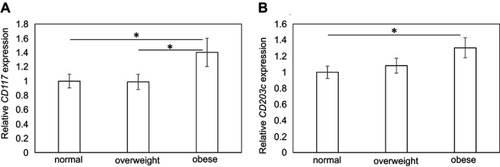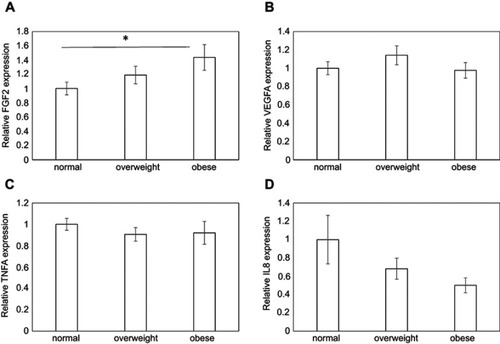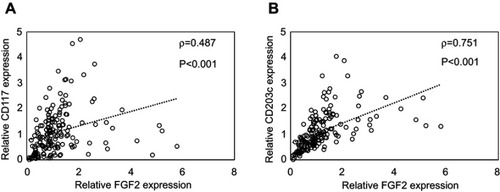Abstract
Purpose:
While research suggests that obesity is a risk factor for knee osteoarthritis (KOA), the mechanisms are not fully understood. Mast cell (MC) numbers are increased in the osteoarthritic synovium and in the adipose tissue of obese individuals. We hypothesized that MC numbers are increased in the synovium of obese KOA patients. This study investigated MC marker and MC-generated cytokine/growth factor expression in the synovium of obese KOA patients.
Patients and methods:
Patients radiographically diagnosed with KOA (male: 38, female: 132) were allocated to three groups based on their body mass index (BMI): normal (<25 kg/m2), overweight (25–29.99 kg/m2) and obese (≥30 kg/m2), according to the World Health Organization BMI classification. We used real-time polymerase chain reaction to compare the expression of MC markers (CD117, CD203c) and growth factors/cytokines (FGF2, VEGFA, TNFA, and IL8) in patients’ synovium among the groups.
Results:
CD117 expression was significantly higher in the obese group than in the normal and overweight groups. CD203c and FGF2 expression were higher in the obese group than in the normal group. FGF2 expression levels were significantly correlated with those of CD117 (ρ=0.487) and CD203c (ρ=0.751).
Conclusion:
MC markers CD117 and CD203c, and FGF2 were highly expressed in the synovium of obese KOA patients. Further investigations are needed to reveal the role of MCs in the relationship between obesity and osteoarthritis pathology.
Keywords:
Introduction
Several reports have suggested that obesity is a risk factor for osteoarthritis (OA), especially knee osteoarthritis (KOA).Citation1–Citation5 Previous studies have suggested that an obese level of body mass results in excess joint loading and increased risk of OA.Citation6,Citation7 Interestingly, reports have also suggested that altered metabolic factors as a result of obesity affect the production of cytokines and growth factors that are associated with OA pathology.Citation8,Citation9 Moreover, the fact that OA is observed in non-weight-bearing joints of obese patientsCitation10,Citation11 implies that mechanical loading may not be the sole contributor, and that other factors may additionally play a role in OA progression. However, these mechanisms are not well established.
Mast cells (MCs) can be found in the synovial tissue, and increased MC numbers have been observed in KOA and rheumatoid arthritis patients, where they are thought to contribute to both acute and chronic inflammatory processes.Citation12 Recent studies suggest that MCs are associated with the severity of radiographic KOA.Citation13 Interestingly, increased MC numbers have also been observed in the adipose tissue of obese individuals, where they are thought to contribute to inflammation.Citation14 However, whether MC numbers are increased in the synovium of obese KOA patients remains to be determined.
Previous studies have implicated several inflammatory cytokines and growth factors in KOA pathology, including tumor necrosis factor (TNF)-ɑ,Citation15 interleukin-8 (IL8),Citation16 fibroblast growth factor-2 (FGF2),Citation17 and vascular endothelial growth factor (VEGF).Citation18 Activated MCs synthesize TNF-ɑ,Citation19–Citation21 IL8,Citation22,Citation23 FGF2Citation24,Citation25 and VEGF.Citation26–Citation28 However, the relationship between obesity and the expression of inflammatory cytokines and growth factors is not well understood.
Here, we investigated MC marker and MC-generated cytokine/growth factor expression in the synovium of obese KOA patients.
Patients and methods
Patients
All subjects underwent total knee arthroplasty (TKA) at our hospital between January 2015 and October 2018. Synovial tissue was extracted during TKA from the subjects (male: 38, female: 132), who were diagnosed with radiographic KOA (unilateral Kellgren/Lawrence grade 3: n=59/170, 34.8%; and grade 4: n=111/170, 65.2%). A portion of each synovial sample was snap frozen in liquid nitrogen and placed in a −80 °C freezer prior to RNA extraction.
This protocol was approved by the Ethics Review Board of Kitasato University (approval number: KMEO B13–113). Participants provided written informed consent to participate in this study and for the removal and use of their synovial tissue one day prior to surgery. This study was conducted in accordance with the Declaration of Helsinki.
Real-time (RT)-polymerase chain reaction (PCR) analysis
All subjects were allocated to three groups based on their body mass index (BMI): normal (<25 kg/m2), overweight (25–29.99 kg/m2) and obese (≥30 kg/m2), according to the World Health Organization (WHO) BMI classification. Patients’ clinical characteristics by group are summarized in .
Table 1 Patients’ clinical characteristics by body mass index group
We evaluated MC markers (CD117, CD203c) inflammatory cytokines (TNFA, IL8) and growth factors (VEGFA, FGF2) on the basis of previous studies which reported that these markers were elevated in OA patientsCitation15–Citation18 and were produced by MC.Citation19–Citation28 RNA extraction, cDNA synthesis and RT-PCR were performed using methods reported previously.Citation29 Primers used for RT-PCR are listed in . We used RT-PCR to compare the expression of CD117, CD203c, FGF2, VEGFA, TNFA, and IL8 in the synovium among the groups.
Table 2 Sequences of primers used in this study
Statistical analysis
SPSS 25.0 was used for statistical analysis. Continuous variables were compared using one-way analysis of variance followed by Fisher’s least significant difference test as a post-hoc test.Citation30 Meanwhile, categorical variables were compared using the Fisher exact test. Spearman’s correlation coefficient was used to evaluate the relationship between the expression of FGF2 and MC markers (CD117 and CD203c). Statistical significance was defined by P<0.05.
Results
Clinical characteristics of patients in normal, overweight, and obese groups
Patients were allocated to three WHO BMI classification groups: normal, overweight and obese. Patients in the obese group were significantly younger than those in the normal and overweight groups (). Male/female ratio and Kellgren/Lawrence grade 3/4 ratio were similar among the groups ().
Expression of MC markers in normal, overweight, and obese groups
To determine whether MC numbers are increased in obese OA patients, we examined the expression level of MC markers in the synovium of KOA patients. CD117 expression was significantly elevated in the obese group compared to the normal (P=0.038) and overweight groups (P=0.031), but was comparable between the normal and overweight groups (P=0.944) (). CD203c expression was significantly elevated in the obese group compared to the normal group (P=0.046) but was comparable with the overweight group (P=0.136) ().
Expression of MC-generated cytokines and growth factors in normal, overweight, and obese groups
FGF2 expression was significantly elevated in the obese group compared to the normal group (P=0.029) but was comparable to the overweight group (P=0.207) (). VEGFA, TNFA, and IL8 expression were similar among the three groups (VEGFA, P=0.389; TNFA, P=0.552; IL8, P=0.232; –D).
Correlation between MC markers and FGF2 expression
Given that MC markers CD117 and CD203c and the MC-generated growth factor FGF2 were elevated in the obese group, we examined the correlation between the expression of CD117 and FGF2, and CD203c and FGF2. FGF2 expression levels were significantly correlated with those of CD117 (ρ=0.487, P<0.001; ) and CD203c (ρ=0.751, P<0.001; ).
Discussion
A number of studies have reported a strong link between the development of KOA and obesity.Citation1,Citation31,Citation32 One study showed that obese KOA patients are 6.8 times more likely to experience KOA progression that those of normal weight.Citation1 Another study reported that the odds ratio for obese individuals developing KOA was 2.6 relative to normal-weight subjects.Citation32 In our study, we found that obese KOA patients underwent TKA at a younger age than normal-weight and overweight patients. Together with previous studies,Citation1,Citation30,Citation31 our findings suggest that obesity is associated with KOA progression.
Studies have reported increased MC numbers in patients with obesity-related glomerulopathyCitation33 and skin tags,Citation34 and obese patients.Citation14 The number of MCs in patients with obesity-related glomerulopathy is significantly and positively correlated with BMI.Citation33 Obese patients with skin tags have significantly more MCs than overweight patients.Citation34 MC numbers are also increased in the adipose tissue of obese patients, where they are thought to contribute to inflammation in white adipose tissue.Citation14 In this study, the synovium of obese KOA patients showed higher expression levels of the MC marker CD117 than that of normal-weight and overweight KOA patients. A recent study showed that there is a relationship between KOA severity and the number of MCs.Citation13 Further investigations are needed to reveal the role of MCs in the relationship between obesity and osteoarthritis pathology.
MCs produce several mediators that contribute to the inflammation process. FGF2 is one growth factor produced by MCs in the inflammatory state.Citation24,Citation25 In our study, FGF2 expression was higher in the synovium of obese KOA patients than that of normal-weight KOA patients, and was correlated with the expression of MC markers CD117 and CD203c. FGF2 promotes matrix metalloprotease-13 production in articular chondrocytes.Citation35,Citation36 FGF2 concentrations in synovial fluid and plasma are correlated with the Kellgren/Lawrence grade.Citation17 Together, our findings and those of previous studies suggest that FGF2 elevation may be associated with increased MC numbers in the synovium of obese KOA patients. However, it is unclear whether FGF2 elevation in obese KOA patients contributes to OA pathology.
Several limitations of the present study warrant mention. First, the inclusion of a non-KOA population is needed to confirm whether MC numbers are increased in obese individuals and if this directly contributes to OA progression. Second, the mechanism by which MCs contribute to OA pathology remains to be determined. Finally, it remains unclear whether the evaluated biomarkers are of sufficient significance to warrant assessment in KOA patients. Other biomarkers should be evaluated in the future.
In conclusion, MC markers CD117 and CD203c, and FGF2 are highly expressed in the synovium of obese KOA patients. Further investigations are needed to reveal the role of MCs in the relationship between obesity and osteoarthritis pathology.
Acknowledgments
This investigation was supported by JSPS KAKENHI Grant No. 18K09119. We thank DMC Corp. (www.dmed.co.jp) for editing drafts of this manuscript.
Disclosure
The authors report no conflicts of interest in this work.
References
- Coggon D , Reading I , Croft P , McLaren M , Barrett D , Cooper C. Knee osteoarthritis and obesity. Int J Obes Relat Metab Disord . 2001;25:622–627. doi:10.1038/sj.ijo.0801585 11360143
- Felson DT. Relation of obesity and of vocational and avocational risk factors to osteoarthritis. J Rheumatol . 2005;32:1133–1135.15977343
- Hart DJ , Spector TD. The relationship of obesity, fat distribution and osteoarthritis in women in the general population: the Chingford Study. J Rheumatol . 1993;20:331–335.8474072
- Lachance L , Sowers M , Jamadar D , Jannausch M , Hochberg M , Crutchfield M. The experience of pain and emergent osteoarthritis of the knee. Osteoarthritis Cartilage . 2001;9:527–532. doi:10.1053/joca.2000.0429 11520166
- Runhaar J , Koes BW , Clockaerts S , Bierma-Zeinstra SM. A systematic review on changed biomechanics of lower extremities in obese individuals: a possible role in development of osteoarthritis. Obes Rev . 2011;12:1071–1082. doi:10.1111/j.1467-789X.2011.00916.x 21812903
- Felson DT. Does excess weight cause osteoarthritis and, if so, why? Ann Rheum Dis . 1996;55:668–670.8882146
- Powell A , Teichtahl AJ , Wluka AE , Cicuttini FM. Obesity: a preventable risk factor for large joint osteoarthritis which may act through biomechanical factors. Br J Sports Med . 2005;39:4–5. doi:10.1136/bjsm.2004.011841 15618330
- Aspden RM. Obesity punches above its weight in osteoarthritis. Nat Rev Rheumatol . 2011;7:65–68. doi:10.1038/nrrheum.2010.123 20717100
- Griffin TM , Guilak F. Why is obesity associated with osteoarthritis? Insights from mouse models of obesity. Biorheology . 2008;45:387–398.18836239
- Grotle M , Hagen KB , Natvig B , Dahl FA , Kvien TK. Obesity and osteoarthritis in knee, hip and/or hand: an epidemiological study in the general population with 10 years follow-up. BMC Musculoskelet Disord . 2008;9:132. doi:10.1186/1471-2474-9-87 18831740
- Oliveria SA , Felson DT , Cirillo PA , Reed JI , Walker AM. Body weight, body mass index, and incident symptomatic osteoarthritis of the hand, hip, and knee. Epidemiology . 1999;10:161–166.10069252
- Nigrovic PA , Lee DM. Synovial mast cells: role in acute and chronic arthritis. Immunol Rev . 2007;217:19–37. doi:10.1111/j.1600-065X.2007.00506.x 17498049
- de Lange-Brokaar BJ , Kloppenburg M , Andersen SN , Dorjee AL , Yusuf E , Herb-van TL , Kroon HM , Zuurmond AM , Stojanovic-Susulic V , Bloem JL , Nelissen RG , Toes RE , Ioan-Facsinay A. Characterization of synovial mast cells in knee osteoarthritis: association with clinical parameters. Osteoarthritis Cartilage . 2016;24:664–671. doi:10.1016/j.joca.2015.11.011 26671522
- Divoux A , Moutel S , Poitou C , Lacasa D , Veyrie N , Aissat A , Arock M , Guerre-Millo M , Clement K. Mast cells in human adipose tissue: link with morbid obesity, inflammatory status, and diabetes. J Clin Endocrinol Metab . 2012;97:E1677–E1685. doi:10.1210/jc.2012-1532 22745246
- Orita S , Koshi T , Mitsuka T , Miyagi M , Inoue G , Arai G , Ishikawa T , Hanaoka E , Yamashita K , Yamashita M , Eguchi Y , Toyone T , Takahashi K , Ohtori S. Associations between proinflammatory cytokines in the synovial fluid and radiographic grading and pain-related scores in 47 consecutive patients with osteoarthritis of the knee. BMC Musculoskelet Disord . 2011;12:144. doi:10.1186/1471-2474-12-181 21714933
- Valcamonica E , Chighizola CB , Comi D , De LO , Pisoni L , Murgo A , Salvi V , Sozzani S , Meroni PL. Levels of chemerin and interleukin 8 in the synovial fluid of patients with inflammatory arthritides and osteoarthritis. Clin Exp Rheumatol . 2014;32:243–250.24529071
- Honsawek S , Yuktanandana P , Tanavalee A , Saetan N , Anomasiri W , Parkpian V. Correlation between plasma and synovial fluid basic fibroblast growth factor with radiographic severity in primary knee osteoarthritis. Int Orthop . 2012;36:981–985. doi:10.1007/s00264-011-1435-z 22173563
- Saetan N , Honsawek S , Tanavalee A , Yuktanandana P , Meknavin S , Ngarmukos S , Tanpowpong T , Parkpian V. Relationship of plasma and synovial fluid vascular endothelial growth factor with radiographic severity in primary knee osteoarthritis. Int Orthop . 2014;38:1099–1104. doi:10.1007/s00264-013-2192-y 24297611
- Bischoff SC , Lorentz A , Schwengberg S , Weier G , Raab R , Manns MP. Mast cells are an important cellular source of tumour necrosis factor alpha in human intestinal tissue. Gut . 1999;44:643–652.10205200
- Ierna MX , Scales HE , Saunders KL , Lawrence CE. Mast cell production of IL-4 and TNF may be required for protective and pathological responses in gastrointestinal helminth infection. Mucosal Immunol . 2008;1:147–155. doi:10.1038/mi.2007.16 19079172
- Nakae S , Ho LH , Yu M , Monteforte R , Iikura M , Suto H , Galli SJ. Mast cell-derived TNF contributes to airway hyperreactivity, inflammation, and TH2 cytokine production in an asthma model in mice. J Allergy Clin Immunol . 2007;120:48–55. doi:10.1016/j.jaci.2007.02.046 17482668
- Moller A , Lippert U , Lessmann D , Kolde G , Hamann K , Welker P , Schadendorf D , Rosenbach T , Luger T , Czarnetzki BM. Human mast cells produce IL-8. J Immunol . 1993;151:3261–3266.8376778
- Salamon P , Shoham NG , Gavrieli R , Wolach B , Mekori YA. Human mast cells release Interleukin-8 and induce neutrophil chemotaxis on contact with activated T cells. Allergy . 2005;60:1316–1319. doi:10.1111/j.1398-9995.2005.00886.x 16135000
- Inoue Y , King TE, Jr , Tinkle SS , Dockstader K , Newman LS . Human mast cell basic fibroblast growth factor in pulmonary fibrotic disorders. Am J Pathol . 1996;149:2037–2054.8952537
- Qu Z , Liebler JM , Powers MR , Galey T , Ahmadi P , Huang XN , Ansel JC , Butterfield JH , Planck SR , Rosenbaum JT. Mast cells are a major source of basic fibroblast growth factor in chronic inflammation and cutaneous hemangioma. Am J Pathol . 1995;147:564–573.7545872
- Boesiger J , Tsai M , Maurer M , Yamaguchi M , Brown LF , Claffey KP , Dvorak HF , Galli SJ. Mast cells can secrete vascular permeability factor/vascular endothelial cell growth factor and exhibit enhanced release after immunoglobulin E-dependent upregulation of fc epsilon receptor I expression. J Exp Med . 1998;188:1135–1145.9743532
- Shaik-Dasthagirisaheb YB , Varvara G , Murmura G , Saggini A , Potalivo G , Caraffa A , Antinolfi P , Tete’ S , Tripodi D , Conti F , Cianchetti E , Toniato E , Rosati M , Conti P , Speranza L , Pantalone A , Saggini R , Theoharides TC , Pandolfi F. Vascular endothelial growth factor (VEGF), mast cells and inflammation. Int J Immunopathol Pharmacol . 2013;26:327–335. doi:10.1177/039463201302600206 23755748
- Sismanopoulos N , Delivanis DA , Alysandratos KD , Angelidou A , Vasiadi M , Therianou A , Theoharides TC. IL-9 induces VEGF secretion from human mast cells and IL-9/IL-9 receptor genes are overexpressed in atopic dermatitis. PLoS One . 2012;7:e33271. doi:10.1371/journal.pone.0033271 22413008
- Minatani A , Uchida K , Inoue G , Takano S , Aikawa J , Miyagi M , Fujimaki H , Iwase D , Onuma K , Matsumoto T , Takaso M. Activation of calcitonin gene-related peptide signaling through the prostaglandin E2-EP1/EP2/EP4 receptor pathway in synovium of knee osteoarthritis patients. J Orthop Surg Res . 2016;11:117. doi:10.1186/s13018-016-0460-4 27751171
- Fisher RA. The Design of Experiments . London: Oliver and Boyd; 1935.
- Fletcher E , Lewis-Fanning E. Chronic rheumatic diseases-part IV: a statistical study of 1,000 cases of chronic rheumatism. Postgrad Med J . 1945;21:176–185.21313447
- Blagojevic M , Jinks C , Jeffery A , Jordan KP. Risk factors for onset of osteoarthritis of the knee in older adults: a systematic review and meta-analysis. Osteoarthritis Cartilage . 2010;18:24–33. doi:10.1016/j.joca.2009.08.010 19751691
- Wang X , Chen H , Zhang M , Liu Z. Roles of mast cells and monocyte chemoattractant protein-1 in the renal injury of obesity-related glomerulopathy. Am J Med Sci . 2013;346:295–301. doi:10.1097/MAJ.0b013e31827559f8 23255244
- Salem SA , Attia EA , Osman WM , El Gendy MA. Skin tags: a link between lesional mast cell count/tryptase expression and obesity and dyslipidemia. Indian J Dermatol . 2013;58:240. doi:10.4103/0019-5154.110843
- Muddasani P , Norman JC , Ellman M , van Wijnen AJ , Im HJ. Basic fibroblast growth factor activates the MAPK and NFkappaB pathways that converge on Elk-1 to control production of matrix metalloproteinase-13 by human adult articular chondrocytes. J Biol Chem . 2007;282:31409–31421. doi:10.1074/jbc.M706508200 17724016
- Im HJ , Muddasani P , Natarajan V , Schmid TM , Block JA , Davis F , van Wijnen AJ , Loeser RF. Basic fibroblast growth factor stimulates matrix metalloproteinase-13 via the molecular cross-talk between the mitogen-activated protein kinases and protein kinase Cdelta pathways in human adult articular chondrocytes. J Biol Chem . 2007;282:11110–11121. doi:10.1074/jbc.M609040200 17311929



